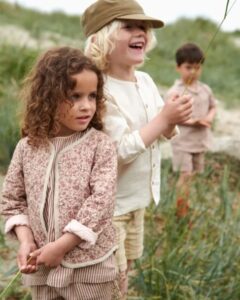Uncategorized
Eco-Conscious Shopping: Tips for Sustainable Kids’ Fashion
Sustainable fashion is no longer just a trend; it’s a necessity. With kids growing out of clothes quickly, it’s easy for parents to fall into the cycle of buying and discarding. However, making eco-conscious choices when shopping for kids’ fashion can significantly reduce waste and environmental impact while fostering a sense of responsibility in the next generation.
Here are practical tips for building a sustainable kids’ wardrobe without compromising on style, quality, or functionality.
1. Invest in High-Quality, Durable Clothing
Durability is key when it comes to sustainable kids’ fashion.
- Why It Matters: High-quality clothes last longer, which means they can be reused, passed down, or resold rather than discarded.
- What to Look For:
- Fabrics like organic cotton, bamboo, and linen.
- Reinforced seams, double stitching, and durable finishes.
- Pro Tip: Avoid fast fashion brands that focus on cheap, low-quality materials. Instead, invest in well-made basics that withstand active play and frequent washing.
2. Opt for Organic and Eco-Friendly Materials
The materials used in kids’ clothing significantly impact the environment.
- Best Choices:
- Organic Cotton: Grown without harmful pesticides and chemicals.
- Recycled Fabrics: Materials like recycled polyester reduce waste and energy consumption.
- Bamboo: A fast-growing, renewable resource that’s soft and breathable.
- Why It Matters: Conventional cotton farming and synthetic materials often require large amounts of water and energy, making organic and recycled options much more sustainable.
3. Choose Gender-Neutral and Timeless Styles
Gender-neutral and timeless designs allow for greater versatility and longevity.
- Why It’s Sustainable:
- Neutral colors and simple designs make clothes easier to pass down among siblings or friends, regardless of gender.
- Classic styles don’t go out of fashion, reducing the need for constant replacements.
- Examples:
- Solid-colored t-shirts, plain leggings, and denim overalls.
- Neutral patterns like stripes, polka dots, or animal prints.
4. Shop Secondhand and Thrift Stores

Buying pre-loved clothes is one of the easiest ways to make your shopping more eco-conscious.
- Benefits:
- Extends the lifespan of clothing, reducing waste.
- More affordable than buying brand-new items.
- Often features unique, one-of-a-kind pieces.
- Where to Look:
- Local thrift stores and consignment shops.
- Online platforms like Poshmark, ThredUp, or Facebook Marketplace.
- Community swap events.
Encouraging kids to shop secondhand can also teach them about the value of reusing and recycling.
5. Support Ethical and Sustainable Brands
Many kids’ fashion brands now focus on sustainability and ethical practices.
- What to Look For:
- Transparent supply chains and fair labor practices.
- Certifications like GOTS (Global Organic Textile Standard) or Fair Trade.
- Brands that prioritize reducing water and energy consumption.
- Top Sustainable Kids’ Brands:
- Primary: Offers timeless, high-quality basics made with eco-friendly materials.
- Hanna Andersson: Known for organic cotton and durable designs.
- Mini Rodini: A premium brand focusing on organic and recycled fabrics.
- Patagonia Kids: Combines performance wear with sustainable practices.
6. Buy Less, Choose Better
Adopting a minimalist approach to kids’ wardrobes is a simple way to embrace sustainability.
- How to Start:
- Build a capsule wardrobe with versatile pieces that can be mixed and matched.
- Stick to essential items, such as 5-7 tops, 3-4 bottoms, and 2-3 pairs of shoes per season.
- Avoid impulse buys and focus on items that your child truly needs.
- Why It Works: A smaller, thoughtfully curated wardrobe reduces waste and encourages mindful consumption.
7. Embrace Upcycling and DIY Projects
Upcycling old clothes into new items is a creative way to reduce waste.
- Ideas for Upcycling:
- Turn outgrown t-shirts into tote bags or patches for jeans.
- Use fabric scraps to create headbands or small toys.
- Add embellishments like embroidery or iron-on patches to refresh plain clothes.
- Benefits:
- Saves money while giving clothes a second life.
- Encourages kids to participate in eco-friendly activities.
8. Wash and Care for Clothes Properly
How you care for clothes plays a big role in their longevity and sustainability.
- Tips for Sustainable Laundry:
- Wash clothes in cold water to save energy.
- Use eco-friendly, biodegradable detergents.
- Air-dry clothing instead of using a dryer to reduce wear and tear.
- Teach Kids to Care: Encourage kids to treat their clothes gently, avoiding unnecessary stains or damage.
Proper care extends the life of clothing, reducing the need for frequent replacements.
9. Participate in Clothing Swaps
Clothing swaps are a fantastic way to refresh your child’s wardrobe without spending money or creating waste.
- How It Works:
- Gather gently used clothing that your child has outgrown.
- Exchange items with friends, family, or at community events.
- Leave with “new-to-you” pieces that suit your child’s current size and style.
- Why It’s Great: Clothing swaps are budget-friendly, eco-conscious, and foster a sense of community.
10. Teach Kids About Sustainability

Involve your children in the process of eco-conscious shopping to instill lifelong habits.
- How to Educate Them:
- Explain the environmental impact of fast fashion and the benefits of sustainable choices.
- Let them choose pre-loved or eco-friendly items when shopping.
- Encourage them to donate or pass down clothes they no longer wear.
- Why It Matters: Teaching kids about sustainability empowers them to make responsible decisions as they grow.
11. Plan for Growth and Longevity
Kids grow quickly, but you can shop strategically to maximize the lifespan of their clothes.
- Tips for Growth:
- Choose adjustable clothing, like pants with elastic waistbands or tops with rollable sleeves.
- Buy slightly larger sizes to allow room for growth.
- Select stretchy, forgiving fabrics that adapt to changing sizes.
- Long-Term Benefits: Planning for growth reduces the need to frequently replace clothing, saving money and resources.
12. Say No to Trends
Trendy items often have a short lifespan, both in terms of durability and style.
- Focus on Timeless Designs: Stick to pieces that never go out of fashion, like plain t-shirts, denim jeans, and simple dresses.
- Avoid Overly Themed Items: Clothing with specific characters or slogans may not age well and could be outgrown quickly.
Choosing classic styles ensures the wardrobe remains relevant and functional for years to come.
Conclusion
Creating a sustainable kids’ wardrobe is all about making thoughtful choices that benefit both the planet and your family. By prioritizing quality, supporting ethical brands, and embracing practices like secondhand shopping and upcycling, you can reduce waste while teaching your child the value of sustainability.
At Regal XX Hue, we’re proud to offer a range of eco-friendly and stylish kids’ clothing that’s perfect for conscious families. Explore our collection today and take the first step toward a more sustainable future!


